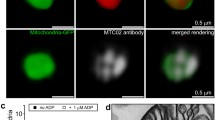Abstract
Although the ultrastructural appearance of mitochondrial crowding after ischemic injury has been reported in myocardial and skeletal muscles, the mechanism for this is not clear. Thirty-five branches of the mesenteric arteries removed from eight patients during surgery were examined by electron microscopy: 22 had ligatures applied 30 minutes to 4 hours before resection, 13 had no ligatures. The number of mitochondria per smooth muscle cell was significantly increased in the arterial segments under the ligature (ligated site) and immediately distal to the ligature (distal site) compared with the nonligated segments (control site). Mitochondria in ischemic cells were also noted to be swollen compared with those in nonischemic cells. Within the ligated site, paradoxically, the severity of ischemic injury correlated inversely with the increase in mitochondrial counts. In conclusion, mitochondria crowding after ischemic injury is due to both swelling and an increase in the number of organelles, and appears as early as 30 min after injury. The results also suggest that, in severely ischemic sites, cells capable of rapidly increasing their mitochondrial count may suffer less ischemic injury.
Similar content being viewed by others
References
Kloner RA, Fishbein MC, Braunwald E, Maroko PR (1978) Effect of propranolol on mitochondria morphology during acute myocardial ischemia. Am J Cardiol 41:880–886.
Jennings RB, Herdson PB, Summers HM (1969) Structural and functional abnormalities in mitochondria isolated from ischemic dog myocardium. Lab Invest 20:548–557.
Jennings RB, Ganote CE (1976) Mitochondrial structure and function in acute myocardial injury. Circ Res 38(suppl 1):80–91.
Murfitt RR, Stiles JW, Powell WJ Jr, Sonadi DR (1978) Experimental myocardial ischemic characteristics of isolated mitochondrial subpopulations. J Mol Cell Cardiol 10:109–123.
Santavirta S, Luoma A, Arstila AU (1978) Ultrastructural changes in striated muscle after experimental tourniquet ischemia and short reflow. Eur Surg Res 10:415–424.
Hanzlikova V, Schiaffino S (1977) Mitochondrial changes in ischemic skeletal muscle. J Ultrastruct Res 60:121–133.
Bush LR, Shlafer M, Haack DW, Lucchesi BR (1980) Time-dependent changes in canine cardiac mitochondrial function and ultrastructure resulting from coronary occlusion and reperfusion. Basic Res Cardiol 75:555–571.
Heffner, Barron SA (1978) The early effects of ischemia upon skeletal muscle mitochondria. J Neurol Sci 38:295–315.
Laguens RP, Weinscheibaum RW, Favaloro R (1979) Ultra-structural and morphometric study of the human heart muscle cell in acute coronary insufficiency. Human Pathol 10:695–705.
van Ekeren GJ, Sengers RC, Stadhouders AM (1992) Changes in volume densities and distribution of mitochondria in rat skeletal muscle after chronic hypoxia. Int J Exp Path 73:51–60.
Armstrong RB, Phelps RO (1984) Muscle fibre type composition of the rat hindlimb. Am J Anat 174:259–272.
Angquist KA, Sjostrom M (1980) Intermittent claudication and muscle fiber fine structure: Morphometric data on mitochondrial volumes. Ultrastruct Pathol 1:461–470.
Buser KS, Kopp B, Gehr P, Weibel ER (1982) Effect of cold environment on skeletal muscle mitochondria in growing rats. Cell Tissue Res 225:427–436.
Kayar SR, Claassen H, Hoppeler H, Weibel ER (1986) Mitochondrial distribution in relation to changes in mescle metabolism in rat soleus. Resp Physiol 64:1–11.
Holm J, Bjomtorp P, Schersten T (1972) Metabolic activity in human skeletal muscle. Effect of peripheral arterial insufficiency. Eur Clin Invest 2:321–325.
Bylund AE, Hammarsten J, Holm H, Schersten T (1976) Enzyme activities in skeletal muscle from patients with peripheral artery insufficiency. Eur J Clin Invest 6:425–429.
Weibel ER (1984) The Pathway for Oxygen. Harvard University Press, Cambridge, p 122.
Julicher RHM, Sterrenberg L, Koomen JM, Bast A, Noordhoek J (1984) Evidence for lipid peroxidation during the calcium paradox in vitamin E-deficient rat heart. Naunyn Schmiedebergs Arch Pharmacol 326:87–89.
Malis CD, Bonventre JV (1986) Mechanism of calcium potentiation of oxygen-free radical injury to renal mitochondria. J Biol Chem 261:14201–14208.
Koller PT, Bergmann SR (1989) Reduction of lipid peroxidation in reperfused isolated rabbit hearts by Diltiazem. Circ Res 65: 838–846.
Hennig B, Chow CK (1988) Lipid peroxidation and endothelial cell injury implications in atherosclerosis. Free Rad Biol Med 4:99–106.
Siems W, Mielke B, Mueller M, Heumann C, Raeder L, Gerber G (1983) Status of glutathione in the rat liver. Enhanced formation of oxygen radicals at low oxygen tension. Biomed Biochim Acta 42:1079–1089.
Marubayashi S, Dohi K, Ochi K, Kawasaki T (1985) Role of free radicals in ischemic rat liver cell injury: Prevention of damage by alpha-tocopherol administration. Surgery 99:184–192.
Jaeschke H, Smith CV, Mitchell JR (1988) Reactive oxygen species during ischemia-reflow injury in isolated perfused rat liver. J Clin Invest 81:1240–1246.
Zweier JL, Flaherty JT, Weisfeldt ML (1987) Direct measurement of free radical generation following reperfusion of ischemic myocardium. Proc Natl Acad Sci USA 84:1404–1407.
Ambrosio G, Flaherty JT, Duillio C, Tritto I, Santoro G, Elia PP, Condorelli M, Chariello M (1991) Oxygen radicals generated at reflow induce peroxidation of membrane lipids in reperfused hearts. J Clin Invest 87:2056–2066.
Szabados G, Tretter L, Horvath I (1989) Lipid peroxidation in liver and Ehrlich and Ehrlich ascites cell mitochondria. Free Radic Res Commun 7:161–170.
Romashkin AD, Wilson GJ, Thomas U, Feitlet DA, Tumiati L, Mickle DAG (1990) Subcellular distribution of peroxidized lipids in myocardial reperfusion injury. Am J Physiol 259:H116-H123.
Posakony JW, England JM. Attardi G (1977) Mitochondrial growth and division during the cell cycle in HeLa cells. J Cell Biol 74:468–491.
Gillham NW (1978) Organelle Heredity. Raven Press, New York.
Alberts B, Bray D, Lewis J, Raff M, Roberts K, Watson JD (1983) The biogenesis of mitochondria and chloroplasts. In: Molecular Biology of the Cell. Garland Publishing Inc, New York, pp 528–529.
Author information
Authors and Affiliations
About this article
Cite this article
Heng, M.K., Allen, S.G., Song, M.K. et al. Mitochondrial crowding in smooth muscle cells after arterial ligation. International Journal of Angiology 5, 1–7 (1996). https://doi.org/10.1007/BF02043455
Issue Date:
DOI: https://doi.org/10.1007/BF02043455




